
Riau is a province of Indonesia. It is located on the central eastern coast of Sumatra along the Strait of Malacca. The province shares land borders with North Sumatra to the northwest, West Sumatra to the west, and Jambi to the south. According to the 2020 census, Riau had a population of 6,394,087 across a land area of 87,023.66 square kilometres; the official estimate as at mid 2021 was 6,493,603. The province comprises ten regencies and two cities, with Pekanbaru serving as the capital and largest city.
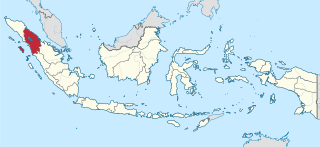
North Sumatra is a province of Indonesia located on the northern part of the island of Sumatra. Its capital and largest city is Medan. North Sumatra is Indonesia's fourth most populous province after West Java, East Java and Central Java, and also the most populous in the island of Sumatra. It covers an area of 72,981 km2. According to the 2020 census, the province's population in that year was 14,799,361. The mid-2021 official estimate is 14,936,148.

The culture of Indonesia has been shaped by long interaction between original indigenous customs and multiple foreign influences. Indonesia is centrally-located along ancient trading routes between the Far East, South Asia and the Middle East, resulting in many cultural practices being strongly influenced by a multitude of religions, including Buddhism, Christianity, Confucianism, Hinduism, and Islam, all strong in the major trading cities. The result is a complex cultural mixture, often different from the original indigenous cultures.

Batak is a collective term used to identify a number of closely related Austronesian ethnic groups predominantly found in North Sumatra, Indonesia, who speak Batak languages. The term is used to include the Karo, Pakpak, Simalungun, Toba, Angkola, and Mandailing which are related groups with distinct languages and traditional customs (adat).

Malay houses refer to the vernacular dwellings of the Malays, an ethno-linguistic group inhabiting Sumatra, coastal Borneo and the Malay Peninsula.

Rumah Gadang or Rumah Bagonjong "house for the Minangkabau people" are the traditional homes of the Minangkabau in West Sumatra, Indonesia. The architecture, construction, internal and external decoration, and the functions of the house reflect the culture and values of the Minangkabau. A Rumah Gadang serves as a residence, a hall for family meetings, and for ceremonial activities. In the matrilineal Minangkabau society, the Rumah Gadang is owned by the women of the family who live there; ownership is passed from mother to daughter.

Singa is an apotropaic figure from the mythology of the Batak people of North Sumatra, Indonesia. The singa represents a benevolent and protective power. The singa is described as "part human, part water buffalo, and part crocodile or lizard". It is variedly represented, but always has an elongated face, with big bulging eyes, a well-defined nose, and long spiralling beard. It is often represented only with its head, but sometimes it may also be represented full body. Other figures - such as other protective deity or ancestral figures - may also be represented standing or sitting on top of the head of the singa.

The architecture of Indonesia reflects the diversity of cultural, historical and geographic influences that have shaped Indonesia as a whole. Invaders, colonizers, missionaries, merchants and traders brought cultural changes that had a profound effect on building styles and techniques.
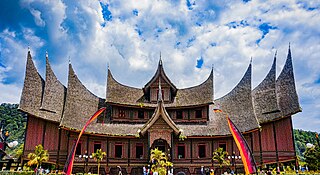
Pagaruyung Palace is the istana of the former Pagaruyung Kingdom, located in Tanjung Emas subdistrict near Batusangkar town, Tanah Datar Regency, West Sumatra, Indonesia. It was built in the traditional Minangkabau Rumah Gadang vernacular architectural style, but had a number of atypical elements including a three-story structure and a larger dimension in comparison to common rumah gadang.

The Simalungun people are an ethnic group in North Sumatra, considered one of the Batak peoples. Simalungun people live mostly in Simalungun Regency and the surrounding areas, including the city of Pematang Siantar, an autonomous city, but previously part of Simalungun Regency.

Toba people also referred to as Batak Toba people are the largest group of the Batak people of North Sumatra, Indonesia. The common phrase of ‘Batak’ usually refers to the Batak Toba people. This mistake caused by the Toba people being the largest sub-group of the Batak ethnic and their differing social habit to self-identify as merely Batak instead of ‘Toba’ or ‘Batak Toba’, contrary to the habit of the Karo, Mandailing, Simalungun, Pakpak communities who commonly self-identified with their respective sub-groups.
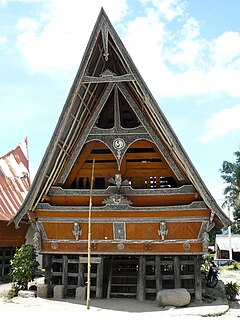
Batak architecture refers to the related architectural traditions and designs of the various Batak peoples of North Sumatra, Indonesia. There are six groups of Batak who speak separate but related languages: the Angkola, the Mandailing to the south, the Toba, to the north the Pakpak/Dairi, the Simalungun, and the Karo. While the groups are now Muslim or Christian, elements of the ancient Batak religion remain, particularly amongst the Karo.

The Indonesian island of Sumatra is the sixth largest island in the world. The rich ethnic diversity and historical heritage in Sumatra is reflected in the range of architectural styles in the island. The vernacular style is the native Sumatran ethnic groups architecture of dwellings, while the Hindu-Buddhist architecture reflected through the cultural historical heritage of candis built in Sumatra. The third wave is Islamic architecture adopted in mosques and palace in Sumatra, especially in Aceh, North Sumatra, and Malay cultural sphere in the island.

Rumah adat are traditional houses built in any of the vernacular architecture styles of Indonesia, collectively belonging to the Austronesian architecture. The traditional houses and settlements of the several hundreds ethnic groups of Indonesia are extremely varied and all have their own specific history. It is the Indonesian variants of the whole Austronesian architecture found all over places where Austronesian people inhabited from the Pacific to Madagascar each having their own history, culture and style.

Batak cuisine is the cuisine and cooking traditions of Batak ethnic groups, predominantly found in Northern Sumatra region, Indonesia. Batak cuisine is part of Indonesian cuisine, and compared to other Sumatran cuisine traditions, it is more indigenously preserved. One characteristic of Batak cuisine is its preference to andaliman as the main spice. That is why andaliman in Indonesia sometimes dubbed as "Batak pepper".
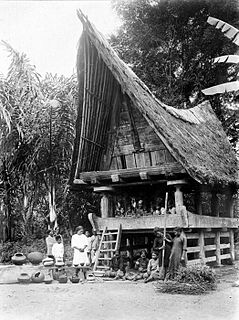
A sopo is a treasury structure in the architecture of the Toba Batak people from North Sumatra, Indonesia. Its form is similar to that of a Batak traditional house with the exception of being smaller in size and a construction ritual that is the opposite of a Batak house. Sopo is used as a repository for various items, e.g. rice, magical items, or trophies. Sopo can also be used as a meeting point for social activities.

A jambur is a structure that is used as a multipurpose hall by the Karo people of North Sumatra, Indonesia. The traditional jambur is a large pavilion-like structure, raised above ground, wall-less, and placed under a large Karo traditional house roof style. Karo ritual ceremonies e.g. wedding feast, funeral, or general feasts are held within the jambur. Jambur can still be found in big cities of North Sumatra, e.g. Medan, Kabanjahe, Berastagi, as well as small villages in the Karo lands.

Geriten, or "head-house", is the skull-house of the Karo people of North Sumatra, Indonesia. It is a pavilion-like structure with a distinctively shaped roof that acted as an ossuary where skulls of chiefs and important individuals are preserved after their deaths.

Rumah ulu is a vernacular house found in the highland of South Sumatra, Indonesia. The house is associated with the Uluan people who reside in the region of the upstream of the Ogan and Musi River.
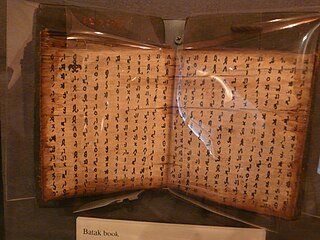
Batak mythology is the original belief that was once adopted by the Batak people of North Sumatra, Indonesia, namely before the arrival of Protestant, Catholic, or Islamic religions. There are various tarombo versions written on pustaha which historians study, but generally refer to the figures below.



















